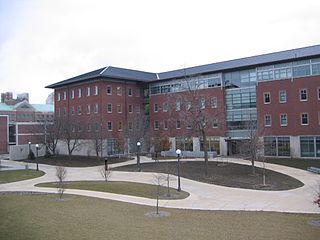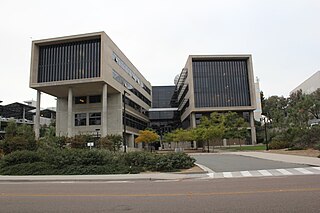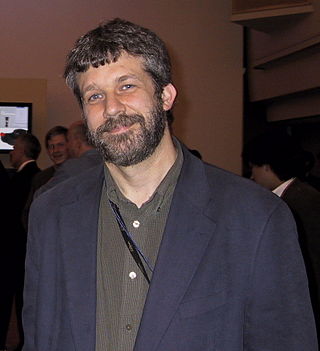Related Research Articles

The National Center for Supercomputing Applications (NCSA) is a state-federal partnership to develop and deploy national-scale cyberinfrastructure that advances research, science and engineering based in the United States. NCSA operates as a unit of the University of Illinois Urbana-Champaign, and provides high-performance computing resources to researchers across the country. Support for NCSA comes from the National Science Foundation, the state of Illinois, the University of Illinois, business and industry partners, and other federal agencies.
Grid computing is the use of widely distributed computer resources to reach a common goal. A computing grid can be thought of as a distributed system with non-interactive workloads that involve many files. Grid computing is distinguished from conventional high-performance computing systems such as cluster computing in that grid computers have each node set to perform a different task/application. Grid computers also tend to be more heterogeneous and geographically dispersed than cluster computers. Although a single grid can be dedicated to a particular application, commonly a grid is used for a variety of purposes. Grids are often constructed with general-purpose grid middleware software libraries. Grid sizes can be quite large.

The San Diego Supercomputer Center (SDSC) is an organized research unit of the University of California, San Diego (UCSD). SDSC is located at the UCSD campus' Eleanor Roosevelt College east end, immediately north the Hopkins Parking Structure.
United States federal research funders use the term cyberinfrastructure to describe research environments that support advanced data acquisition, data storage, data management, data integration, data mining, data visualization and other computing and information processing services distributed over the Internet beyond the scope of a single institution. In scientific usage, cyberinfrastructure is a technological and sociological solution to the problem of efficiently connecting laboratories, data, computers, and people with the goal of enabling derivation of novel scientific theories and knowledge.

TeraGrid was an e-Science grid computing infrastructure combining resources at eleven partner sites. The project started in 2001 and operated from 2004 through 2011.

Charlie Catlett is a senior computer scientist at Argonne National Laboratory and a visiting senior fellow at the Mansueto Institute for Urban Innovation at the University of Chicago. From 2020 to 2022 he was a senior research scientist at the University of Illinois Discovery Partners Institute. He was previously a senior computer scientist at Argonne National Laboratory and a senior fellow in the Computation Institute, a joint institute of Argonne National Laboratory and The University of Chicago, and a senior fellow at the University of Chicago's Harris School of Public Policy.

European Grid Infrastructure (EGI) is a series of efforts to provide access to high-throughput computing resources across Europe using grid computing techniques. The EGI links centres in different European countries to support international research in many scientific disciplines. Following a series of research projects such as DataGrid and Enabling Grids for E-sciencE, the EGI Foundation was formed in 2010 to sustain the services of EGI.
The Texas Advanced Computing Center (TACC) at the University of Texas at Austin, United States, is an advanced computing research center that is based on comprehensive advanced computing resources and supports services to researchers in Texas and across the U.S. The mission of TACC is to enable discoveries that advance science and society through the application of advanced computing technologies. Specializing in high performance computing, scientific visualization, data analysis & storage systems, software, research & development and portal interfaces, TACC deploys and operates advanced computational infrastructure to enable the research activities of faculty, staff, and students of UT Austin. TACC also provides consulting, technical documentation, and training to support researchers who use these resources. TACC staff members conduct research and development in applications and algorithms, computing systems design/architecture, and programming tools and environments.
The George E. Brown, Jr. Network for Earthquake Engineering Simulation (NEES) was created by the National Science Foundation (NSF) to improve infrastructure design and construction practices to prevent or minimize damage during an earthquake or tsunami. Its headquarters were at Purdue University in West Lafayette, Indiana as part of cooperative agreement #CMMI-0927178, and it ran from 2009 till 2014. The mission of NEES is to accelerate improvements in seismic design and performance by serving as a collaboratory for discovery and innovation.

Renaissance Computing Institute (RENCI) was launched in 2004 as a collaboration involving the State of North Carolina, University of North Carolina at Chapel Hill (UNC-CH), Duke University, and North Carolina State University. RENCI is organizationally structured as a research institute within UNC-CH, and its main campus is located in Chapel Hill, NC, a few miles from the UNC-CH campus. RENCI has engagement centers at UNC-CH, Duke University (Durham), and North Carolina State University (Raleigh).
The National E-Infrastructure Service (NES), formerly the National Grid Service, was an organisation for UK academics and researchers from 2004 through 2011. It was funded by two governmental bodies, Engineering and Physical Sciences Research Council (EPSRC) and the Joint Information Systems Committee (JISC).

nanoHUB.org is a science and engineering gateway comprising community-contributed resources and geared toward education, professional networking, and interactive simulation tools for nanotechnology. Funded by the United States National Science Foundation (NSF), it is a product of the Network for Computational Nanotechnology (NCN). NCN supports research efforts in nanoelectronics; nanomaterials; nanoelectromechanical systems (NEMS); nanofluidics; nanomedicine, nanobiology; and nanophotonics.
The National Institute for Computational Sciences (NICS) is funded by the National Science Foundation and managed by the University of Tennessee. NICS was home to Kraken, the most powerful computer in the world managed by academia. The NICS petascale scientific computing environment is housed at Oak Ridge National Laboratory (ORNL), home to the world's most powerful computing complex. The mission of NICS, a member of the Extreme Science and Engineering Discovery Environment (XSEDE - formerly TeraGrid), is to enable the scientific discoveries of researchers nationwide by providing leading-edge computational resources, together with support for their effective use, and leveraging extensive partnership opportunities.
Discovery Net is one of the earliest examples of a scientific workflow system allowing users to coordinate the execution of remote services based on Web service and Grid Services standards. The system was designed and implemented at Imperial College London as part of the Discovery Net pilot project funded by the UK e-Science Programme. Many of the concepts pioneered by Discovery Net have been later incorporated into a variety of other scientific workflow systems.
Integrated computational materials engineering (ICME) involves the integration of experimental results, design models, simulations, and other computational data related to a variety of materials used in multiscale engineering and design. Central to the achievement of ICME goals has been the creation of a cyberinfrastructure, a Web-based, collaborative platform which provides the ability to accumulate, organize and disseminate knowledge pertaining to materials science and engineering to facilitate this information being broadly utilized, enhanced, and expanded.
Polish Grid Infrastructure PL-Grid, a nationwide computing structure, built in 2009-2011, under the scientific project PL-Grid – Polish Infrastructure for Supporting Computational Science in the European Research Space. Its purpose was to enable scientific research based on advanced computer simulations and large-scale computations using the computer clusters, and to provide convenient access to the computer resources for research teams, also outside the communities, in which the high performance computing centers operate.

The iPlant Collaborative, renamed Cyverse in 2017, is a virtual organization created by a cooperative agreement funded by the US National Science Foundation (NSF) to create cyberinfrastructure for the plant sciences (botany). The NSF compared cyberinfrastructure to physical infrastructure, "... the distributed computer, information and communication technologies combined with the personnel and integrating components that provide a long-term platform to empower the modern scientific research endeavor". In September 2013 it was announced that the National Science Foundation had renewed iPlant's funding for a second 5-year term with an expansion of scope to all non-human life science research.
A data infrastructure is a digital infrastructure promoting data sharing and consumption.
Data Infrastructure Building Blocks (DIBBs) is a U.S. National Science Foundation program.
Science gateways provide access to advanced resources for science and engineering researchers, educators, and students. Through streamlined, online, user-friendly interfaces, gateways combine a variety of cyberinfrastructure (CI) components in support of a community-specific set of tools, applications, and data collections.: In general, these specialized, shared resources are integrated as a Web portal, mobile app, or a suite of applications. Through science gateways, broad communities of researchers can access diverse resources which can save both time and money for themselves and their institutions. As listed below, functions and resources offered by science gateways include shared equipment and instruments, computational services, advanced software applications, collaboration capabilities, data repositories, and networks.
References
- 1 2 3 4 Bohle, S. "What is E-science and How Should it Be Managed?" Nature.com, Spektrum der Wissenschaft (Scientific American), http://www.scilogs.com/scientific_and_medical_libraries/what-is-e-science-and-how-should-it-be-managed/.
- ↑ IEEE International Conference on eScience, homepage, accessed December 18, 2014, https://escience-conference.org/
- 1 2 DT&SC 7-2: Computational Social Science. https://www.youtube.com/watch?v=TEo0Au1brHs From the DT&SC online course at the University of California: https://canvas.instructure.com/courses/949415
- ↑ Stewart Tansley; Kristin Michele Tolle (2009). The Fourth Paradigm: Data-intensive Scientific Discovery. Microsoft Research. ISBN 978-0-9825442-0-4.
- ↑ Bell, G.; Hey, T.; Szalay, A. (2009). "COMPUTER SCIENCE: Beyond the Data Deluge". Science. 323 (5919): 1297–1298. doi:10.1126/science.1170411. ISSN 0036-8075. PMID 19265007. S2CID 9743327.
- ↑ DT&SC 7-1: Introduction to e-Science: https://www.youtube.com/watch?v=9x3d75ZMuYU . From the DT&SC online course at the University of California: https://canvas.instructure.com/courses/949415
- 1 2 Hilbert, M. (2015). e-Science for Digital Development: ICT4ICT4D. Centre for Development Informatics, SEED, University of Manchester. "Archived copy" (PDF). Archived from the original (PDF) on 2015-09-24. Retrieved 2015-08-13.
{{cite web}}: CS1 maint: archived copy as title (link) - ↑ Executive Office of the President, Office of Science and Technology Policy, "Memorandum for the Heads of Executive Departments and Agencies: Increasing Access to the Results of Federally Funded Scientific Research." February 22, 2013, accessed July 7, 2013, https://obamawhitehouse.archives.gov/sites/default/files/microsites/ostp/ostp_public_access_memo_2013.pdf.
- ↑ "National e-Science Centre". official website. Archived from the original on 16 December 2008. Retrieved 29 September 2011.
- ↑ Richard Poynder (12 December 2006). "A Conversation with Microsoft's Tony Hey". Open and Shut? blog. Retrieved 20 September 2011.
It just happens that in the US they chose another name. Personally, I think e-Science is a much better name than cyberinfrastructure.
Full transcript Archived March 25, 2012, at the Wayback Machine updated 15 December 2006. - ↑ "Office of Cyberinfrastructure (OCI)" . Retrieved 19 September 2011.
- ↑ "Swedish e-Science Research Center(SeRC)".
- ↑ "eSSENCE, The e-Science Collaboration".
- ↑ Syed, J.; Ghanem, M.; Guo, Y. (2007). "Supporting scientific discovery processes in Discovery Net". Concurrency and Computation: Practice and Experience. 19 (2): 167. doi:10.1002/cpe.1049. S2CID 16212949.